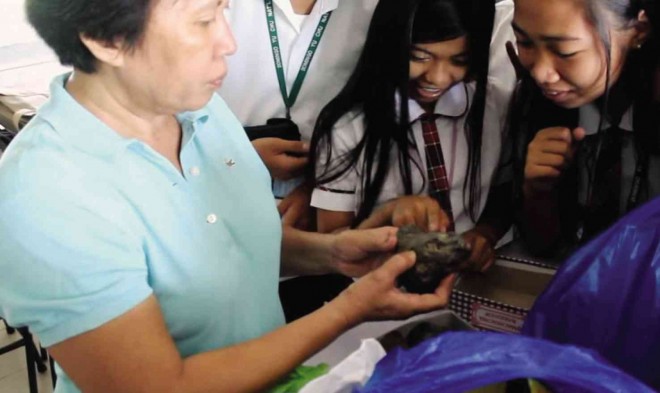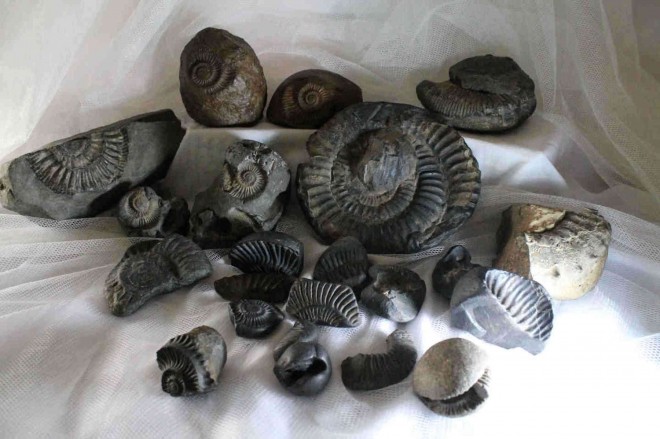Mindoro students ‘discover’ Jurassic town
In their search for a unique story about their province Oriental Mindoro, a group of high school students came upon a remarkable discovery: Ammonites, the most widely known fossils dating back to the age of the dinosaurs 165 million years, were found in the town of Mansalay in the 1940s.
For this reason, Mansalay has been dubbed the “Jurassic Park of the Philippines” by the Mines and Geosciences Bureau (MGB).
The students of Domingo Yu Chu National High School in Pola town decided to spread the news using the tools of the technological age. In the process, they won a crowdsourcing contest called “Doon Po sa Amin” (DPSA), which is designed to mine the most unique stories about Philippine culture and heritage.
With the help of teacher-coaches, they produced a video about the ammonites of Mansalay, in particular those found recently by a resident, Susan Belen Viaña, a rock collector. The video is titled “Doon Po sa Amin, Ang Mga Bato ay may Nakatagong Kwento” (roughly, “In our Town, the Stones have Secrets”). It won the grand prize in the student division of the 7th annual DPSA, the first and only contest of its kind, conducted by Smart Communications Inc. in partnership with the Department of Education.
Sea creatures
DPSA is an annual search for the best hometown stories showcasing the history, traditions, festivals, points of interest, notable people, unique plants and animals, special delicacies and products of a place. These are all mapped online via the DPSA website.
Ammonites are fossil shells of creatures that lived in the sea as far back as 450 million years ago; they belong to a group of cephalopods, which include octopus, squid and cuttlefish.
Not many people, even in Mindoro, knew about them, and the students hoped to get the word out, particularly to the scientific community.
The video explains that, according to the National Museum, the discovery of ammonites in Mansalay is proof that part of the Philippines was once under the sea.
It was the students’ teacher-adviser, Steve Marc Ines, who first learned about the fossils—on Facebook. When he saw the photos Viaña had posted of her collection, he knew he had found the perfect subject for his students’ contest entry.
Ines contacted Viaña, asking if his team could visit her and view her collection. Viaña offered instead to bring her collection to the school, thus paving the way for its very first exhibit, in August 2014. A month later another exhibit was held, this time for students from all over Oriental Mindoro.
“She has about a ton of these rocks in her home, and we would like to be able to help her with her dream of having a museum built to house her archaeological finds,” Ines says of Viaña.

ROCK COLLECTOR Susan Belen-Viaña shows her ammonites to students of Domingo Yu Chu National High School in Pola town in Oriental Mindoro province. CONTRIBUTED PHOTO
Richest harvest
Student Paul Daryl Marco says that “hopefully, through the exhibits and with our video, we can help spread awareness about the ammonites.”
True enough, the DPSA video caught the attention of Unesco (United Nations Educational, Scientific and Cultural Organization). Representatives have expressed interest in visiting Mansalay to conduct further studies.
Viaña’s story is no less fascinating. She narrates in the video that she has long been an avid collector of unusually shaped rocks and stones, which she assembles in rock gardens.
When she heard about the ammonites, she embarked on a search, at times enlisting the help of the Mangyan community in Mansalay. In one such hunt, she found ammonites embedded in a rock wall near a river.
Rewarded with her “richest harvest” from Mansalay Bay between 2008 and 2010, she was inspired to do her own research. She found out that in 2010, four species of newly discovered Jurassic ammonites in the area were reported by a team from the National Museum, the MGB, and the National Museum of Nature and Science in Tokyo. The ammonites were found in a river valley near Mansalay, and further south, in Colasi Point, Tablas Island, Romblon.
Viaña also learned that the Mansalay ammonites antedate those found in Catanduanes by 65 million years.
“People think these things are worthless,” she laments in Filipino in the video. “If we only did a little research, we would learn to appreciate their value.” She hopes that the local government will pursue the plan to build a fossil museum, saying it would boost tourism and spur development, especially for the benefit of the Mangyan community.
It will primarily benefit the students, she says. “Who knows? Some of them might become scientists someday, and they will then be able to raise the awareness of the next generation.”
Ines believes that the DPSA project has indeed inspired the students to go into the sciences, if not fossil collection. “As a science-and-technology-oriented high school, we want to stimulate our students’ interest in scientific discoveries and develop scientific thinking,” he says, citing the Science and Technology Education program and ICT (Information and Communications Technology) Club.
With the DPSA video, he hopes all Mindoreños will feel prouder of their province.
Hidden treasures
Speaking for his team, Marco says he is thankful to Smart “for the opportunity to show the world the ammonites … our hidden treasures … to reach out to people our age, and link our past to our future.”
“We also showed [other] students that the Internet is a useful source of knowledge,” says team member Harold Kent C. Baldonado. The other team members are Daryl A. Mercado, Lovely Charmaine B. Llave, Pamela Angel M. Morente, Charlene L. Reforma and Danilo M. Dris Jr. The other teacher-coaches are Cleotilde Bruce and Elbert Z. Salazar.
Since its launch, DPSA has generated over 1,500 hometown stories. “DPSA allows Filipinos to take part in documenting Philippine culture and history using technology for all the world to see,” says Smart Public Affairs Group head Ramon R. Isberto.
To view DPSA entries, go to www.doonposaamin.ph. Or follow DPSA on Facebook at www.facebook.com/DoonPoSaAmin, on Twitter at www.twitter.com/doonposaaminph, or subscribe to its YouTube channel at www.youtube.com/DoonPoSaAminPH for more Pinoy local stories.















